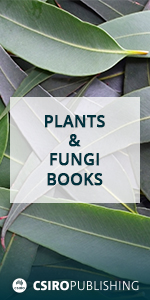Australian Journal of Botany
Volume 61
Number 8 2013
The Cretaceous palaeoclimate on land is poorly understood when compared with sea-surface estimates. Using the relationship between the shape and size of woody dicot leaves and climate, we determined that, ~93 million years ago, Lark Quarry, central-western Queensland, was warm and wet. This insight allows us to further understand the environment in which angiosperms and associated insects diversified in, as well as the climatic conditions experienced by the area’s diverse vertebrate fauna.
We analysed the susceptibility of Eucalyptus globulus and E. maidenii to Teratosphaeria nubilosa. E. maidenii was less damaged than E. globulus but the change to adult foliage began significantly earlier on E. globulus. The work highlights the selection opportunities for sites at high risk of T. nubilosa infection.
Different growth environments can result in different leaf structure. In the present study, Dalbergia nigra (Atlantic forest species) and D. miscolobium (cerrado species) exhibited high phenotypic plasticity to light, although in different leaf traits. The forest species was more plastic when considering leaf traits that may be related to gas exchange (number of leaflets per leaf, stomatal pore area and density, percentage of leaflet occupied by stomatal pore area, and estimated stomatal conductance), whereas the cerrado species showed higher plasticity in light-interception traits, such as leaflet mass per area and leaflet thickness.
Increasing seeding root growth potential is a critical factor in determining restoration success of banksia-woodland systems. Optimising nutrient regimes during nursery production provides an opportunity to increase root growth of Banksia and Eucalyptus species when outplanted into field conditions.
The study of the embryonic development of palms is essential for understanding the establishment and evolutionary success of these plants. The aim of this study was to carry out a morpho-anatomical analysis of the embryo of Syagrus inajai, in different phases of its development, culminating in the establishment of four specific development stages. These states are observed in other species of palms. The existence of an embryonic development pattern in this family is therefore proposed.
Variation in mating system has important fitness and evolutionary consequences for plants. We examined the effects of forest fragmentation on the mating system of Eucalyptus pauciflora and showed that, while outcrossing rates were not affected, seed yield was reduced by fragmentation. This finding means that seed from remnant native trees of this species is unlikely to show deleterious effects of inbreeding and that locally collected seed is suitable for ecological restoration unless maladapted due to climate or other environmental change.
Understanding the ability of species to recolonise after disturbances created by forest harvesting is critical for sustainable forestry. This paper examined how bryophyte recolonisation was impacted by distance to a mature forest. Recolonisation of bryophytes declined with increasing distance to a mature forest and therefore the distance between retained mature forest patches should be considered in the management of forest harvesting.
Lepidosperma scabrum is a common understorey species currently required for urban bushland restoration, though its propagation has been highly problematic to date. In this study, the type of seed dormancy present in this species is defined along with the requirements to promote high levels of germination.
Many remnant populations of the Environment Protection and Biodiversity Conservation Act 1999-listed Eucalyptus strzeleckii K.Rule (Strzelecki gum) are dominated by large, senescing trees and recruitment is rarely observed. The present study documented regeneration of saplings in good-quality habitats. The key variables influencing recruitment were identified and have implications for land managers.




